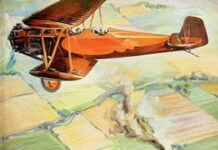The world breathed easier as peace began to return to the sky. Millions of young people returned home with new life skills, keen to resume their lives over again.
There was a huge surplus of aircraft and pilots. These came together to create a world where they could fly almost as free as birds, and establish new records of personal endurance.
Air passenger and freight services began to pick up, taking advantage of an oversupply of aircraft, and wartime aviators thirsting to be in the sky again.
Development of new aircraft slowed in the face of radically reduced demand for new. Those that succeeded faced higher hurdles, because the balance between supply and demand had made a step change.
The History of Flight in 1919
JANUARY 1919
- French pilots Capitaine Coli and Lieutenant Roget complete a 450-mile double crossing of the Mediterranean Sea between Marseille and Algier, in a Levasseur PL.8 biplane.
- Converted British Airco DH.4s start transporting passengers and mail between London and Paris to administratively support the Versailles Peace Conference.
- British pilots Major A. S. C. MacLaren and Captain Robert Halley arrive in Delhi, India after a flight from England in a Handley Page V/1500 heavy bomber.
- Frenchman Jules Védrines takes up a dare, and lands his Caudron G-3 biplane on a department store roof in Paris. He wrecks his aircraft, and is injured. But he claims the FF25,000 prize.
Farman F.60 Goliath Helps Kickstart Commercial Flight (Jan 1919)
The Farman F.60 Goliath was a 1918 French World War 1 bomber that came to production too late to join the conflict. However, the big, box-like fuselage made conversion to an airliner feasible, and the giant aircraft was instrumental in the creation of early airlines, and commercial routes in Europe after hostilities were over.

https://en.wikipedia.org/wiki/File:Farman-goliath.jpg
The Farman F-68BN4 Goliath was a fixed-undercarriage, three-bay biplane of fabric-covered wood construction, powered by two 450 hp engines. It had a simple and robust, yet light structure. The wings were rectangular with a constant profile with ailerons fitted to both upper and lower wings.
The modification for commercial flight produced accommodation for 12 to 14 passengers benefiting from a view of their surroundings. Farman sold some 60 of the new version, while eight Goliaths with various engines were built under license in Czechoslovakia. The original military version also served in numerous defense forces.

https://en.wikipedia.org/wiki/File:FarmanGoliathCSA.jpg
The specification of the Farman F-68BN4 Goliath was as follows:
- Length 48.5 ft, height 16 ft, empty weight 6,393 lb, gross weight 11,905 lb
- Wing span 87 ft, wing area 1,700 ft, crew four, passengers twelve to fourteen
- Two Gnome 9-cylinder air-cooled radial piston engines, 450 hp each
- Max speed 110 mph, range 500 mi, ceiling 18,000 ft, 9,800 ft in 20 min

https://en.wikipedia.org/wiki/Farman_F.60_Goliath#/media/File:Farman_F.60_Goliath_3-view_Flight_October_2,_1919.jpg
FEBRUARY 1919
- Germany’s Deutsche Luft-Reederei company starts a regular commercial service between Berlin and Weimar some 55 miles apart. They use AEG and DFW biplanes.
- Non-military international flights are still officially prohibited. Frenchman Lucien Bossoutrot gets around the problem by transporting 12 former military pilots in uniform in his Farman F.60 Goliath from France to England to promote plans for civilian aviation.
Thomas-Morse MB-3 The First Effective U.S. Fighter (Feb 1919)
The U.S. air force asked several local manufacturers to design a new fighter in March 1918. The Thomas-Morse MB-3 was Boeing’s response, and the chunky biplane went on to become America’s mainstay fighter for the Air Service between 1922 and 1925.

https://en.wikipedia.org/wiki/File:MB-3_Pursuit_at_Selfridge_Field.jpg
The Thomas-Morse MB-3 shared common features with the French-built SPAD XIII fighter it replaced. Accordingly, the pilot sat in an open cockpit under a cut-out in the upper wing, with two 0.30 inch Marlin machine-guns mounted ahead. The construction was wood and fabric with fixed conventional landing gear.
The U.S. air force ordered 50 after successful testing, despite pilots commenting the cockpit was cramped and gave a poor view for the pilot. Improved MB-3A versions arrived in mid-1922. The aircraft served satisfactorily until 1926, when Curtiss PW-8 and Boeing PW-9 fighters began to phase it out.

https://commons.wikimedia.org/wiki/File:Women_making_Thomas-Morse_MB-3A_wings_at_the_Boeing_factory,_ca._1919-1922s.jpg
The specification of the Thomas-Morse MB-3 was as follows:
- Length 20 ft, height 8.5 ft, wing span 26 ft, wing area 229 sq ft
- Empty weight 1,716 lb, gross weight 2,539 lb, crew one
- Max speed 141 mph, endurance 2.5 hr, ceiling 19,500 ft, 1,235 ft / min
- Wright H V-8 piston engine, 300 hp by Spanish Hispano-Suiza
- Two fixed forward firing 0.30 inch machine guns (various types)
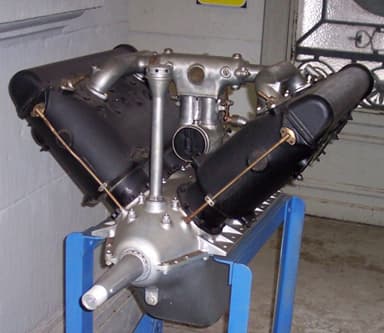
https://commons.wikimedia.org/wiki/File:Hispano_Suiza_8_A_Brussel.jpg
MARCH 1919
- An airmail service began between Folkestone, England, and Cologne in Germany using British war-surplus fighter biplanes. Some 922 flights take place connecting the homeland with military stationed across the Channel.
- American pioneer William Boeing transports United States airmail between Vancouver, British Columbia, Canada, and Seattle, Washington, using a Boeing CL-4S seaplane trainer.
- The Prime Minister of Australia announces a reward for the first aviator who will fly from the United Kingdom to Australia in less than 30 days.
- The Farman brothers in France establish their Société Générale des Transports Aériens. They begin a regular air service between Paris and Brussels using a converted F.60 Goliath bomber.
APRIL 1919
- The Société Générale des Transports Aériens flies 14 passengers to an altitude of 20,000 feet in their Farman F.60 Goliath airliner to publicize their service.
- Lieutenant Roget of the French army’s aeronautical division flies from Lyons, France to Rome, Italy, and then back to Nice, France. His Breguet 14 biplane bomber traverses a distance of approximately 1,000 miles on the journey.
- The French company Compagnie des Messageries Aériennes CMA begins a mail and freight service between Paris and Lille some 160 miles away using ex-military Breguet 14 biplane bombers.
- The British North Sea Aerial Navigation Company starts a passenger air service between Leeds and Hounslow some 125 miles away, with ex-military Blackburn Kangaroo reconnaissance torpedo bombers.
Nieuport Nighthawk Fighter Has Limited Success (April / May 1919)
The Nieuport Nighthawk was a British fighter aircraft Nieuport & General Aircraft purpose-built for the British air force. It emerged in the scramble towards the end of World War 1, but only enjoyed very limited success.

https://weaponsandwarfare.com/2015/08/28/nighthawk-nieuport-british-fighter-biplane/
The Nieuport Nighthawk was a wooden, two-bay biplane that attracted an early order of 150 in August 1918. However, prototype testing in April / May 1919 revealed extreme overheating, high fuel consumption and severe vibrations.
It did, however, show excellent performance when the engine could be persuaded to work. The project was cancelled by which time 1,147 engines had been delivered. These found their way into other projects.
The specification of the Nieuport Nighthawk was as follows:
- Length 18.5 ft, height 9.5 ft, wing span 28 ft, wing area 276 sq ft
- Empty weight 1,500 lb, gross weight 2,218 lb, crew one
- ABC Dragonfly I 9-cylinder radial engine, 320 hp
- Max speed 151 mph, endurance 3 hr, ceiling 24,500 ft, 7 min to 10,000 ft
- Armament: 2 × fixed forward-firing .303 inch Vickers machine guns
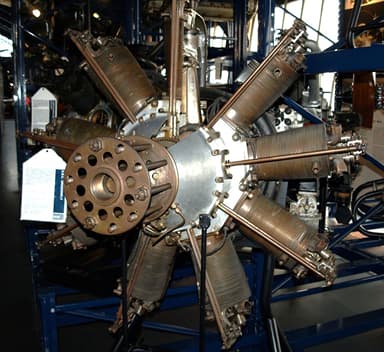
https://en.wikipedia.org/wiki/ABC_Dragonfly#/media/File:Picture_or_Video_017.JPG
MAY 1919
- A Fairey IIIC seaplane is recommissioned to deliver the Evening Times newspaper to towns along the Kent county coast in England.
- The United States Post Office inaugurates an intercity air route between Chicago, Illinois, and Cleveland, Ohio. One return trip covers some 690 miles.
- A Curtiss NC-4, four engine flying boat becomes the first aircraft to cross the Atlantic Ocean, albeit after two scheduled stops. It departs from Trepassey Bay, Newfoundland and arrives in Horta in the Azores after traversing some 1,375 miles.
- New York hotel owner Raymond Orteig offers the Orteig Prize for the first non-stop flight between Paris and New York.
The Farman Moustique Bringing Aviation to the People (May 1919)
Many people longed to learn to fly, and even own their own aircraft now the war was over. The Farman Moustique aimed to meet that need with a family of wooden light-weight monoplanes covered with fabric. The design was so minimal the fuselage only reached to the pilot’s waist.
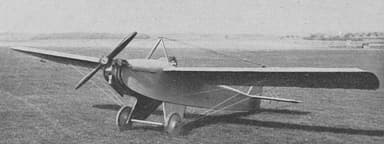
https://commons.wikimedia.org/wiki/File:Farman_Moustique_L%27Aerophile_January_1942.jpg
The first flight of the prototype took place in May 1919. The minimalist airplane was little more than a motorized glider, in fact non-motorized versions proved popular. Approximately 59 were manufactured for a variety of purposes
Some 36 went to the French government seventeen years later, when the design was revived. They were part of its Aviation Populaire program intended to bring people from all walks of life into aviation, and make pilots of them.
The general specification of the Farman Moustique family was as follows:
- Length 21 ft, height 6 ft, wing span 26.5 ft, wing area 113 sq ft
- Empty weight 333 lb, gross weight 628 lb, crew one
- Ava 4A-00 2-cylinder horizontally opposed two-stroke boxer, 25 hp
- Max speed 81 mph, range 220 mi, moderate climb rate
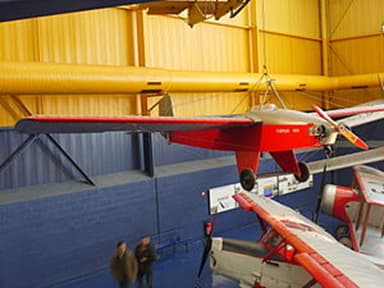
https://en.wikipedia.org/wiki/File:Farman_455_Musee_du_Bourget_P1010712.JPG
JUNE 1919
- World War surplus Curtiss JN-4 flying boats discover a new peacetime role, after they are stationed at San Diego in California, United States as a permanent forest fire patrol.
- The British government dispatches 12 Airco DH.9A aircraft via aircraft carrier to Somaliland to help quell a rebellion. This was the first known example of using aircraft in a colonial policing role.
- Canada becomes the first nation to comprehensively legislate and implement rules for managing aerial military defense, and controlling all non-military government flying operations.
- Captain John Alcock and Lieutenant Arthur Whitten Brown make the first successful non-stop Atlantic crossing by air. They fly from Newfoundland to Ireland in a Vickers Vimy in sixteen hours, and scoop the Daily Mail prize.
- The first all-metal commercial airplane, the Junkers F.13, flies for the first time. The advanced cantilever-wing monoplane offers enclosed accommodation for four passengers and sets a standard for others to follow.
First All-Metal Commercial Aircraft Junkers F.13 (June 25, 1919)
The Junkers F 13 was the world’s first all-metal transport aircraft. Its history began towards the end of World War 1. When it emerged for its first test flight on June 25, 1919, the low, cantilever wing monoplane had enclosed accommodation for four passengers.

https://en.wikipedia.org/wiki/File:Junkers-f13.jpg
The design followed the traditional Junkers approach of a duralumin structure entirely covered with corrugated and stressed duralumin skin. Some 322 planes were produced over 13 years, an exceptionally large number for a commercial airliner of the era. They operated all over the globe, with some in commercial service for more than 30 years.
Accommodation for the crew was basic, with the semi-enclosed cockpit roofed but without side glazing. The passengers luxuriated in an enclosed and heated cabin, with windows and doors in the fuselage sides, and seats fitted with seat belts, an unusual consideration at the time.
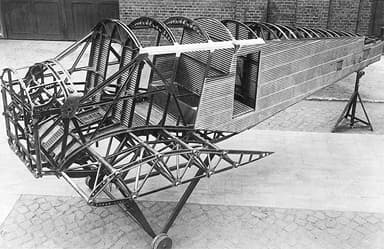
https://commons.wikimedia.org/wiki/File:F13_fuselage.jpg
The general specification of the Junkers F 13 was as follows:
- Length 31.5 ft, height 11.5 ft, wing span 48.5 ft, wing area 371 sq ft
- Empty weight 2,097 lb, crew two, four passengers or 1,519 lb payload
- Mercedes D.IIIa 6-cyl.water-cooled in-line piston engine, 158 hp
- Max speed 107 mph, cruise 99 mph, range 870 mi, ceiling 16,000 ft
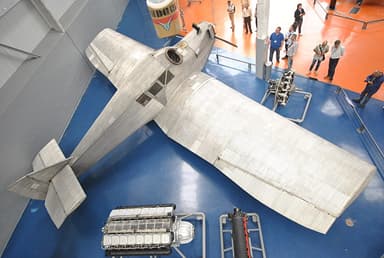
https://en.wikipedia.org/wiki/File:Mus%C3%A9e_de_l%27air_-_Junkers_F.13.jpg
JULY 1919
- London opens its first commercial airport, the Hounslow Heath Aerodrome heralding Britain’s first international flights. It was still only a grass airfield, but it did boast a permanent customs hall.
- The Italian Army’s top test pilot, Lieutenant Francesco Breck-Papa pilots a Fiat BR light bomber 745 miles from Rome to Paris. His was the first non-stop flight between two European capitals.
- Anthony Fokker establishes the Dutch Aircraft Factory near Amsterdam, apparently to bypass the Armistice agreement. The factory dominates the civil aviation industry in the 1920’s and 1930’s.
AUGUST 1919
- Italian aviator Antonio Locatelli completes the first roundtrip crossing of the Andes in a single-seater Ansaldo SVA.5. He crosses the mountains from Mendoza to Valparaiso, and then returns to Chile via Santiago traversing some 950 miles.
- Canada’s Captain Ernest Charles Hoy completes the first aircraft crossing of the Rocky Mountains in a Curtis JN-4 Jenny. His 869 mile journey takes 12 hours 24 minutes flying time to complete.
- A Farman F.60 Goliath airliner flies eight passengers and a ton of supplies from Paris, France to Koufa, Senegal. It travels via Casablanca, French Morocco, and Mogador, French Morocco traversing some 2,795 miles.
- The British Aircraft and Transport Company starts the first, regularly scheduled airline service between London and Paris. It flies a pre-war British de Havilland DH.16 four-seat airplane between London Hounslow Heath Aerodrome, and Le Bourget Airport in Paris.
SEPTEMBER 1919
- Italian World War I ace Giovanni Ancillotto makes a six-hour, 817 mile nonstop flight from Rome to Warsaw and is feted on arrival. Poland responds by ordering 75 Ansaldo biplanes for its air force.
- French airline Compagnie des Messageries Aériennes (CMA) commences a regular service between Paris and London. It uses ex-military Breguet 14 bombing / reconnaissance aircraft.
- The British Aerial Transport Company begins domestic flights between London and Birmingham in a Koolhoven FK.26 four-passenger airplane.
OCTOBER 2019
- American pilot Rudolph Schroeder, sets a new altitude world record of 31,568 feet in a Packard-Le Peré LUSAC-11 two-seater biplane fighter.
- British airline Handley Page Transport begins offering refreshments on its London – Brussels service. The three-shilling meal consists of a sandwich, fruits and chocolate.
Twenty-nine countries underwrite the Paris ‘Convention Relating to the Regulation of Aerial Navigation’, effective 1922. The document states:
- Each country has absolute sovereignty over its airspace.
- Each country must treat all aircraft in its airspace equally regardless of their nationality.
- Each aircraft must be registered in a country.
- Each aircraft carries the nationality of the country in which it is registered.
- French pilot Bernard de Romanet sets a new world speed record of 167 mph flying a Nieuport-Delage 29v single seat biplane.
The Customizable Avro 548 Multi-Purpose Biplane (Oct 1919)
Aircraft development was at a crossroads in 1919. The old conflict over borders and sovereignty lingered on in various places, while in America and Europe markets flooded with war surplus airplanes.
Some of these aircraft converted to commercial use, while others were in private hands. At the same time the powerful nations demanded faster, deadlier fighting machines and weapons. The British Avro 548, which first flew in October 1919, was an attempt to satisfy both markets with the same core product.
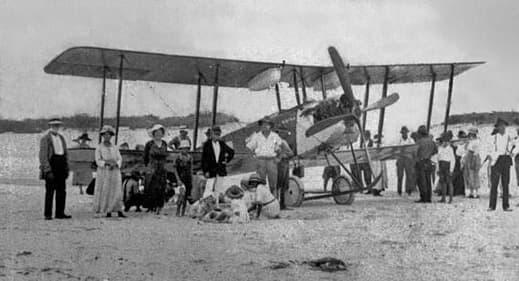
https://en.wikipedia.org/wiki/File:StateLibQld_1_194247-519x.jpg
The Avro 548 based extensively on the earlier, wartime Avro 504 of which 11,303 were built, including Japanese, Soviet and other non-British production. Accordingly, it was a two-bay all-wooden biplane with a square-section fuselage.
The first prototype used a Curtiss OX-5 V-8 engine, but this proved impractical for the civilian market on account of the engine’s weight, and the complexity of its cooling system. However, the Renault 80 hp air-cooled V-8 engine met requirements.

http://flyingmachines.ru/Site2/Crafts/Craft33193.htm
Most Avro 548’s, of which 38 were produced between 1920 and 1925, were customized versions for private buyers. Some were civilian pilot trainers, while others found roles in joyriding, personal transport, and racing. Latvian and Portuguese air forces acquired two each, presumably for pilot training.
The specification of the Avro 548 was as follows:
- Length 29.5 ft, height 10.5 ft, wing span 36 ft, wing area 330 sq ft
- Empty weight 1,338 lb, gross weight 1,943 lb, one pilot, two passengers
- Renault 80 hp (Type WS) air-cooled V-8 engine , 80 hp
- Max speed 80 mph, cruise 65 mph, range 175 mi, 350 ft per min
NOVEMBER 1919
- West Indies Airways commences a passenger service between Key West, Florida, and Havana, Cuba. It uses several Airco D.H.4a VIII single-engine biplane bombers modified to include an enclosed cramped space in the fuselage with room for two passengers.
- Keith and Ross Macpherson Smith scoop the Australian government prize by flying a Vickers Vimy heavy bomber 11,293 miles from England to Darwin, Australia with numerous stop overs.
- Captain Henry Wrigley and Sergeant Arthur Murphy complete the first south-north flight across Australia in a Royal Aircraft Factory B.E.2e two seat biplane. They fly from Melbourne to Darwin – a distance of some 1,950 miles – after a total 47 hours in the air.
French Company Blériot Tries Its Civilian Wings (Nov 1919)
French aircraft manufacturer Blériot may have been running out of options by mid-1919, with a glut of wartime surplus aircraft on the market. However, it successfully converted to a blend of military and civilian versions, of which the Blériot-SPAD S.27 was one of its earliest passenger aircraft.

http://www.airwar.ru/enc/cw1/s27.html
The Blériot-SPAD S.27 was an adaption of the Blériot-SPAD S.20 into a micro airliner. It had accommodation for two passengers in the fuselage behind the pilot, this being the only significant modification.
Blériot supplied 10 of the airplanes to the pioneering French airline CMA (Compagnie des Messageries Aériennes) which used them on its Paris-London route. CMA merged with Air Union in 1923 which subsequently became part of Air France.

https://commons.wikimedia.org/wiki/File:Spad_S.27_-_Lieut._Jean_Casale_110320_p297.png
The specification of the Blériot-SPAD S.27 was as follows:
- Length 24 ft, height 9 ft, wing span 32 ft, wing area 320 sq ft
- Empty weight 1,874 lb, gross weight 2,778 lb, crew one
- Hispano-Suiza 8Fa water-cooled V8 engine, 300 hp
- Max speed 140 mph, endurance 3 hr, ceiling 26,400 ft
DECEMBER 1919
- Columbia institutes a law regulating aviation companies, and everything else in Colombia related to aviation.
Potez SEA VII Exhibits at Paris Air Salon (December 25, 1919)
The Potez SEA VII was a civilian version of the Dassualt French SEA IV fighter aircraft. This was so successful the Ministry of Armament and War Production ordered 1,000 planes. However, the armistice meant only 115 were completed.

https://en.wikipedia.org/wiki/File:Potez_VII_L%27A%C3%A9ronautique_September_1921.jpg
The modified civilian version had a two-person, enclosed cabin on the after-fuselage, and enlarged wings to allow slower, gentler landings. It exhibited at the Paris Air Show in December 1919. French-Romanian airline Cie Franco-Roumaine purchased twenty-five examples for service to Eastern European destinations during the 1920s.
The specification of the Potez SEA VII was as follows:
- Length 28 ft, height 10 ft, wing span 46 ft, wing area 473 sq ft
- Empty weight 2,310 lb, gross weight 3,630 lb, crew one, passengers two
- Lorraine-Dietrich 12Da V12 engine 370 hp, cruise speed 110 mph

https://commons.wikimedia.org/wiki/File:Potez_VII_Paris_1919_150120_p69.jpg
SIAI S.16 on Show at Paris Air Salon (December 25, 1919)
The SIAI S.16 was one of Italian aircraft manufacturer SAIA-Marchetti’s early successes. It was a biplane flying boat with room for five passengers, and went on to become ‘one of the most successful flying-boats of the 1920s’.
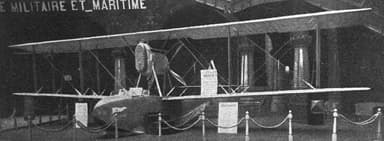
https://commons.wikimedia.org/wiki/File:SIAI_S.16_Paris_1919_220120_p93.jpg
The specification of the SIAI S.16 was as follows:
- Length 32.5 ft, height 12 ft, wing span 51 ft
- Empty weight 1,852 lb, gross weight 5,847 lb
- Lorraine-Dietrich 12Db vee piston engine
- Max speed 120 mph, range 629 mi, ceiling 13,125 ft
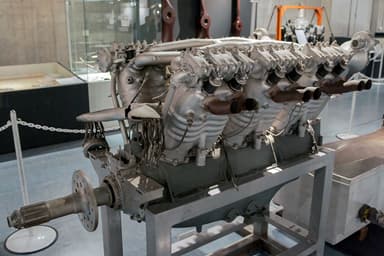
https://en.wikipedia.org/wiki/Lorraine_12D#/media/File:Lorraine_400hp_aircraft_engine_front-left_2010_The_Sky_and_Space.jpg
Handley Page W.8 Britain’s First Purpose-Built Airliner (Dec 1919)
The Handley Page W.8 evolved from a series of bomber aircraft, although it was purpose-made to carry civilian passengers. An enclosed cabin for 12 people with on-board w.c. added a luxurious touch, although the pilot and navigator had to brave the elements in an open cockpit up front.

https://en.wikipedia.org/wiki/File:HP_W.8b.jpg
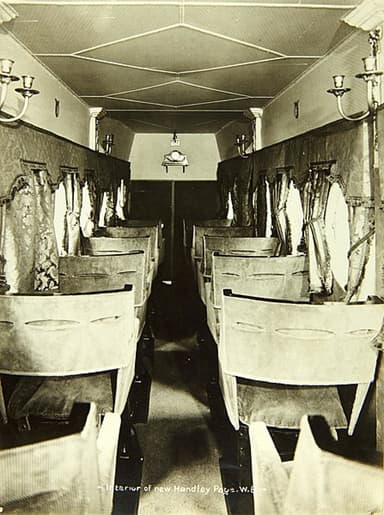
https://commons.wikimedia.org/wiki/File:Handley_Page_W.8_cabin_(7585341244).jpg
The prototype W.8, powered by two 450 hp Napier Lion engines first flew on 4 December 1919, shortly after it made its appearance at the 1919 Paris Air Show in Le Bourget.
However, those motors were substituted in the W.8b by more economical Rolls-Royce Eagle IX versions. A number of enhancements followed, including adding a third engine in the nose of the biplane.
The specification of the later Handley Page W.8f was as follows:
- Length 60 ft, height 17 ft, wing span 75 ft, wing area 1,456 sq ft
- Empty weight, 8,600 lb, gross 13,000 ft, crew two, passengers twelve
- One Rolls-Royce Eagle IX V-12 water-cooled piston engine, 360 hp in nose
- Two water-cooled Siddeley Puma 6-cylinder engines, 240 hp between wings
- Max speed 103 mph, cruise 85 mph, service ceiling 13,000 ft
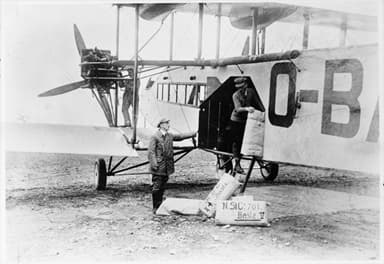
https://commons.wikimedia.org/wiki/File:Handley_Page_W.8b_of_Sabena_transferring_cargo_-_LBS_SR01-01982.tif
Boeing’s First Commercial Model the B-1 Seaplane (Dec 1919)
The Boeing B-1 was a good product, but the market was still flooded with war-surplus aircraft and it only produced one prototype. Nonetheless, it is worthy of mention because it was an important milestone in the evolution of the Boeing Company. The layout was conventional, with the engine driving a pusher propeller mounted midship amongst the cabane struts.
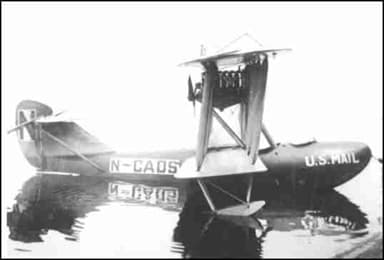
https://www.earlyaviators.com/ehubbard.htm
The pilot sat in an open cockpit at the bow, while up to two passengers could travel in a second open cockpit behind the pilot. Pioneering aviator Edward Hubbard purchased the single prototype, and it flew until 1930 before being preserved.
The specification of the Boeing B-1 was as follows:
- Length 31 ft, height 13.5 ft, wing span 50 ft, wing area 492 sq ft
- Empty weight 2,400 lb, gross 3,850 lb, one crew, two passengers
- Hall-Scott Liberty L-6 water-cooled inline aircraft engine, 200 hp
- Max speed 90 mph, cruise 80 mph, range 40 mi, ceiling 13,300 ft
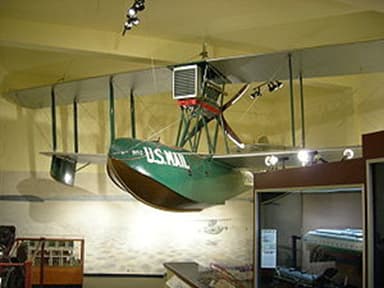
https://en.wikipedia.org/wiki/Boeing_B-1#/media/File:MOHAI_plane.jpg





